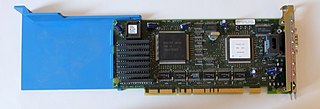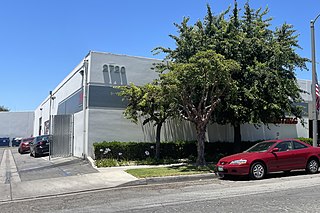
Industry Standard Architecture (ISA) is the 16-bit internal bus of IBM PC/AT and similar computers based on the Intel 80286 and its immediate successors during the 1980s. The bus was (largely) backward compatible with the 8-bit bus of the 8088-based IBM PC, including the IBM PC/XT as well as IBM PC compatibles.

The IBM Personal Computer is the first microcomputer released in the IBM PC model line and the basis for the IBM PC compatible de facto standard. Released on August 12, 1981, it was created by a team of engineers and designers directed by William C. Lowe and Philip Don Estridge in Boca Raton, Florida.

The Tandy 1000 is the first in a line of IBM PC compatible home computer systems produced by the Tandy Corporation for sale in its Radio Shack and Radio Shack Computer Center chains of stores. Introduced in 1984, the product line was aimed at providing affordable but capable systems for home computing or education, with some of its Tandy specific features like graphics, sound and joystick port making it more appealing for home use.

Micro Channel architecture, or the Micro Channel bus, is a proprietary 16- or 32-bit parallel computer bus introduced by IBM in 1987 which was used on PS/2 and other computers until the mid-1990s. Its name is commonly abbreviated as "MCA", although not by IBM. In IBM products, it superseded the ISA bus and was itself subsequently superseded by the PCI bus architecture.

The MPU-401, where MPU stands for MIDI Processing Unit, is an important but now obsolete interface for connecting MIDI-equipped electronic music hardware to personal computers. It was designed by Roland Corporation, which also co-authored the MIDI standard.

AST Research, Inc., later doing business as AST Computer, was a personal computer manufacturer. It was founded in 1980 in Irvine, California, by Albert Wong, Safi Qureshey, and Thomas Yuen, as an initialism of their first names. In the 1980s, AST designed add-on expansion cards, and evolved toward the 1990s into a major personal computer manufacturer. AST was acquired by Samsung Electronics in 1997 but was de facto closed in 1999 due to a series of losses.
During the late 1980s, Intel sold two ISA expansion cards named Intel Inboard 386/AT and Intel Inboard 386/PC, which allowed users to upgrade an IBM AT or an IBM PC respectively. The boards allowed users to upgrade their machines' CPU to a 16 MHz 80386 processor. Both variants utilized a ribbon cable which plugged into the computer's original CPU socket on one end and into a socket on the Inboard card on the other end.
Pravetz is a brand of personal computers produced in Bulgaria from 1979. They were widely used in scientific organizations and schools until the 1990s.

The Vollrath Company is an American company based in Sheboygan, Wisconsin that manufactures stainless steel and aluminum equipment and smallwares, and deep draw stainless steel items, for commercial and institutional foodservice operations.

The IBM Personal Computer XT is the second computer in the IBM Personal Computer line, released on March 8, 1983. Except for the addition of a built-in hard drive and extra expansion slots, it is very similar to the original IBM PC model 5150 from 1981.

The IBM ThinkPad Power Series(800/820/821/822/823/850/851/860) is a laptop series from the ThinkPad line that was manufactured by IBM. It is based on the PowerPC architecture.

Reply Corporation, often shortened to Reply Corp., was an American computer company based in San Jose, California. Founded in 1988 by Steve Petracca, the company licensed the Micro Channel architecture from IBM for their own computers released in 1989, competing against IBM's PS/2 line. The company later divested from offering complete systems in favor of marketing motherboard upgrades for older PS/2s. Reply enjoyed a close relationship with IBM, owing to many of its founding employees, including Petracca, having worked for IBM. The company was acquired by Radius in 1997.

American Computer & Peripheral, Inc. (AC&P), also written as American Computer and Peripheral, was an American computer company based in Santa Ana, California. The company was founded in 1985 by Alan Lau and released several expansion boards for the IBM PC as well as a few PC clones before going bankrupt in December 1989. Obscure in its own time, the company's 386 Translator was the first plug-in board for Intel's newly released 80386 processor and the first mass-market computing device to offer consumers a means of using the 386 in July 1986.

Advanced Logic Research, Inc. (ALR), was an American computer company founded in 1984 in Irvine, California by Gene Lu. The company marketed IBM PC compatibles across that standard's evolution until 1997 when it was acquired by Gateway 2000.

The Personal System/2 Model 30 and Personal System/2 Model 30 286 are IBM's entry-level desktop computers in their Personal System/2 (PS/2) family of personal computers. As opposed to higher-end entries in the PS/2 line which use Micro Channel bus architecture, the Model 30 features an Industry Standard Architecture bus, allowing it to use expansion cards from its direct predecessors, the PC/XT and the PC/AT. The original PS/2 Model 30 is built upon the Intel 8086 microprocessor clocked at 8 MHz; the Model 30 286 features the Intel 80286 clocked at 10 MHz.

Aox Inc. was a privately run American technology corporation founded by Michael and Linda Aronson in 1978. Over the course of its 22-year lifespan, the company chiefly developed software and hardware for IBM's PC and compatibles, for the Personal System/2, and for the Macintosh. In its twilight years, the company designed multimedia and teleconferencing devices and chip designs. Aox was founded after Michael Aronson graduated from Harvard University with a doctorate in physics; he stayed with the company until 2000, when he incorporated EndPoints Inc. and switched to full-time fabless semiconductor design.

Cumulus Corporation was an American computer peripheral and system manufacturer active from 1987 to 1993. Based in Beachwood, Ohio and started by Tecmar founder Martin Alpert, the company set out to exclusively manufacture expansion products for IBM's Personal System/2 (PS/2) family of computers—mainly RAM expansion cards. It later released cross-platform CPU upgrade cards and memory expansion cards for other platforms besides the PS/2. Beginning in 1990, the company began trading as Cumulus Computer Corporation and began releasing complete systems of their own. Initially a success story for the tech industry in Cleveland, a botched stock launch in 1992 proved disastrous for the company's ailing cash flow situation, and in 1993 the company was liquidated amid massive debt to suppliers and lenders.
Ogivar Technologies Inc. was a Canadian computer company founded in Montreal, Quebec, in 1982 and 1992. Active for roughly a decade, the company primarily manufactured IBM PC compatibles before having the majority of its assets bought out by Tandem International, a electrochemical company, following bankruptcy proceedings. It was once one of Canada's top manufacturers of personal computers.
Innovation SSI-2001 is a sound card for IBM PC compatible computers introduced by the Innovation Computer Corporation in 1989. Unique to its design was the use of the MOS Technology SID as its sound chip of choice.
Xebec Corporation, formerly Microcomputer Systems Corporation, was an American computer hardware company active from 1969 to 1990. The company was primarily known for their data storage products, especially their hard disk controller ICs. A major customer of Xebec was IBM, who used their disk controllers extensively in the PC XT in 1983, their first PC with a hard drive preinstalled.














